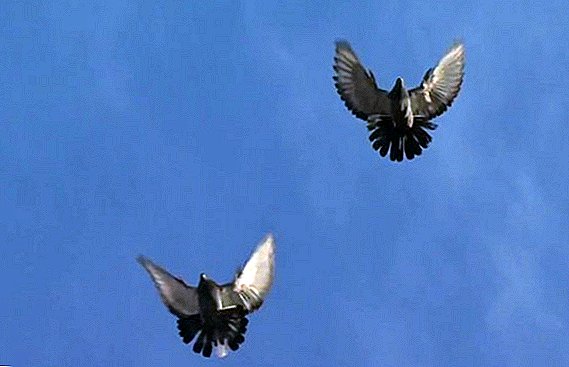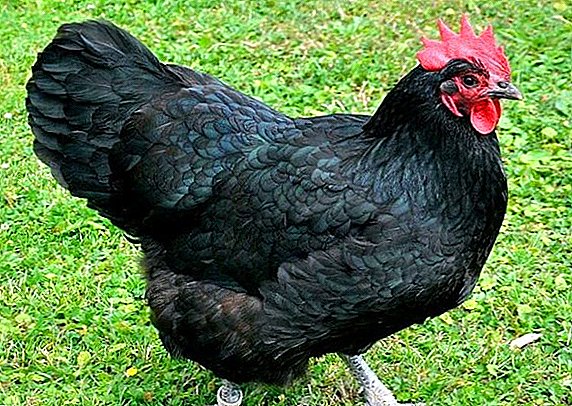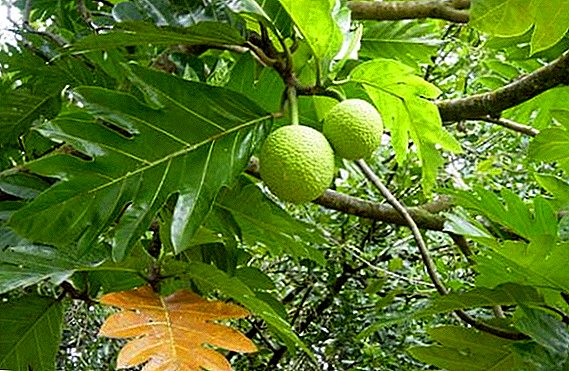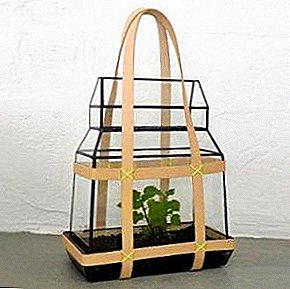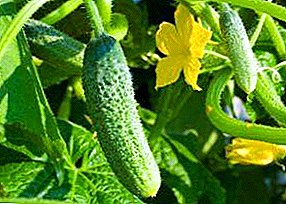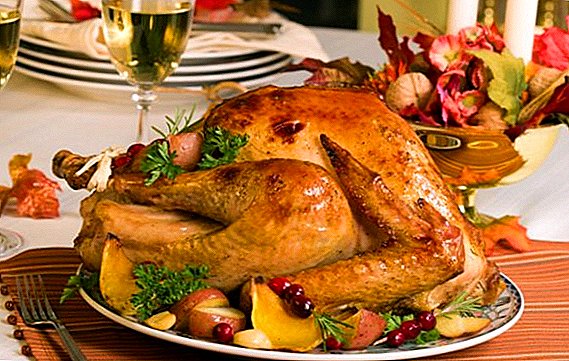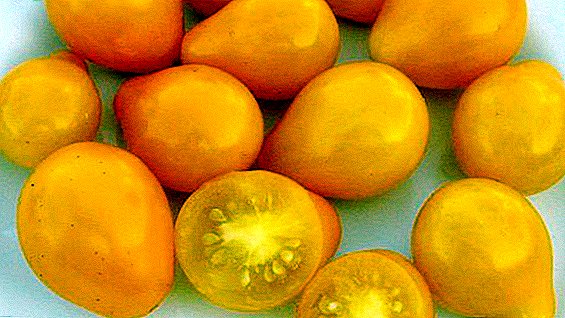 We will introduce you to an interesting plant - weigela. Let's talk about features of the weigel, as well as planting and caring for her in the open field. We will teach you how to propagate a plant, how to prune correctly, and also to deal with pests and diseases.
We will introduce you to an interesting plant - weigela. Let's talk about features of the weigel, as well as planting and caring for her in the open field. We will teach you how to propagate a plant, how to prune correctly, and also to deal with pests and diseases.
Did you know? The plant was named after the German professor of chemistry and botany Christian Ehrenfried von Weigel. This shrub was an indispensable element of the traditional Chinese and Japanese landscape garden.
Virtues of weigela
Weigela is a shrub whose homeland is East and Southeast Asia. There grow wild species of shrubs. The genus includes 15 species of plants.
The main advantages of weigela are simplicity and a large number of breeding methods, the beauty of the inflorescences and ease of care. When flowering, the bush forms a huge number of flower stalks, which turn it into a huge ball covered with flowers. Shrub also tolerates frost and other stressful conditions.
The most popular types of weigela
Breeders have brought many species of weigels that are striking in their beauty and originality. So that you can choose a suitable shrub, we will present most popular varieties.
Weigela Middendorf
 Bush of this species has a height of 150 cm with ascending shoots. The leaves are bright green in color, the inflorescences are sulfur-yellow with orange spots. In the inflorescence collected up to 6 flowers. Weigela Middendorf blooms in spring and autumn with a duration of 1 month.
Bush of this species has a height of 150 cm with ascending shoots. The leaves are bright green in color, the inflorescences are sulfur-yellow with orange spots. In the inflorescence collected up to 6 flowers. Weigela Middendorf blooms in spring and autumn with a duration of 1 month.
Weigela nice
Important! Seeds of this species do not ripen in the middle lane.
This species is rarely found in gardens. Bush has a height of 130 cm leaves oblong-lanceolate bright green color. The flowers have a pink-purple color outside and pale pink inside. It blooms just 2 times a year - in May-June and August-September.
Japanese weigela
Japanese weigela has a height of 100 cm, leaves ellipsoid to 10 cm in length. Flowers pale pink, bell-funnel-shaped. On one pedicel forms 3 flowers.
Important! This type of weigela can not tolerate frost even in shelter.Korean weigela
 Cultivated shrubs has a height of 150 cm (wild - 5 meters). Leaves pointed, shiny. The flowers have a color from pale pink to bright carmine (at the end of flowering), diameter - 3 cm. It pleases with flowering just 2 times a year (as with weigela pleasant). Blossoms from 15 to 30 days (this period may vary with each flowering). Seeds, unfortunately, do not ripen in the middle lane.
Cultivated shrubs has a height of 150 cm (wild - 5 meters). Leaves pointed, shiny. The flowers have a color from pale pink to bright carmine (at the end of flowering), diameter - 3 cm. It pleases with flowering just 2 times a year (as with weigela pleasant). Blossoms from 15 to 30 days (this period may vary with each flowering). Seeds, unfortunately, do not ripen in the middle lane.
Important! Requires shelter for the winter.Weigela early
This kind of weigela has a height of 150-200 cm growing in China and North Korea on rocky slopes. The leaves are dark green broadly. The flowers are collected in inflorescences of 2-3, have a pink color on the outside and purple-red inside. It blooms in May and June, the duration of flowering - 10-30 days. Weigela Garden
Bush in height to 100 cm, looks similar to the Korean look. Leaves in the shape of an egg, up to 10 cm long. Flowers can appear both at the ends of shoots and in the leaf axils, have a tubular shape and a dull pink color. Abundant bloom begins in the 3rd decade of May and until the beginning of June. With age, the plant's resistance to frost increases.
Important! This view requires shelter for the winter..
Weigela Maksimovich
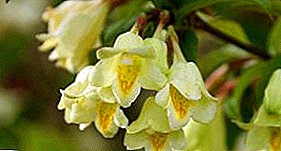 Weigela Maksimovich has a height of 150 cm. The leaves are pointed to the top, length up to 8 cm. Flowers have a pale yellow color and funnel-shaped. Flowering takes place from the second half of May to mid-June. In this species, by the middle of October, the seeds ripen even in the middle lane.
Weigela Maksimovich has a height of 150 cm. The leaves are pointed to the top, length up to 8 cm. Flowers have a pale yellow color and funnel-shaped. Flowering takes place from the second half of May to mid-June. In this species, by the middle of October, the seeds ripen even in the middle lane.
Analyzing the types we can single out one leader - Weigel Maksimovich, which gives viable seeds even in more northern latitudes. If you live in the south, then you can choose based on your own preferences.
Correct fit
Choose a place for planting, planting time and prepare the site.
Did you know? Weigela in landscape design is used for group plantings and single, on the slopes and slopes, to create a free-form living hedge and in compositions with perennial plants.
Optimum landing times
Many florists are concerned about the issue when you need to plant and replant the weigela.
 Weighel should be planted only in spring. The optimal period is March-April (between the beginning of the warm-up of the soil and the swelling of the kidneys). If you plant a bush in the fall, it may not survive the frost, even if you cover it.
Weighel should be planted only in spring. The optimal period is March-April (between the beginning of the warm-up of the soil and the swelling of the kidneys). If you plant a bush in the fall, it may not survive the frost, even if you cover it.
If you bought weigela in the fall, then do not panic. The plant will be able to wait until spring. Just dig the bush under the slope and cover the ground.
Shrub transplantation is done only in the spring, so that before winter he can adapt and accumulate nutrients.
Choosing a landing site
For landing, choose a hill that is closed from the north winds. Weigela does not tolerate drafts (the wind knocks the inflorescences), so the place should not be heavily purged. The ideal option would be the south side. The bush will feel even better if there is a building behind it; this way you will precisely save the plant from the draft.
Preparation of soil for planting seedlings
The plant is demanding to the soil, so its composition should be taken seriously. Weigela prefers sandy or loamy soil with weakly alkaline, and preferably neutral, reaction. Also, the soil should be rich in humus and trace elements. Before planting, the bottom of the pit is covered with gravel or other drainage. Then chernozem (or other fertile soil) with fertilizers (100 g of nitrophoska and 7.5 kg of compost) are filled up.
 Do not forget to mix the nitrophore well with the compost, otherwise you will burn the roots of the plant. When preparing the soil is worth remembering that Weigela doesn’t like waterlogged soil therefore, such areas immediately disappear. The same applies to areas with high groundwater storage.
Do not forget to mix the nitrophore well with the compost, otherwise you will burn the roots of the plant. When preparing the soil is worth remembering that Weigela doesn’t like waterlogged soil therefore, such areas immediately disappear. The same applies to areas with high groundwater storage.
Bushes during the season
You planted the weigela, now you need to properly care for it, so that the shrubs are healthy and twice a year to please you with luxurious flowers. So, we turn to the consideration of care for the weigela.
Mode of irrigation
Water weigela need to need. If it has not been raining for a long time and the ground began to dry up, water the bush (about 5-8 liters per bush). No need to saturate the soil with moisture, otherwise the roots will begin to rot. In this case, there is no certain amount of watering, but it is worth knowing that if you have mulched the bushes, then you need to water much less often, since the mulch retains moisture. Also, the plant should be plentifully watered after winter (about 8-10 liters under a bush), if it is frozen. On the care of veigela spring, we will describe below.
Mulch and top dressing of the soil
Weigela needs mulching and fertilizing the soil, so read this section carefully to keep the shrub healthy.
Important! If you do not feed the weigela in the spring, the plant may not bloom, or its flowering will be short. In the worst case, the bush can dry out at all due to lack of strength.
 In early spring (when the snow has not melted yet) mineral fertilizers are applied under the bush (20 g of urea, 10 g of superphosphate and 10 g per meter of potash fertilizers). This will give additional strength to the plant weakened after winter.
In early spring (when the snow has not melted yet) mineral fertilizers are applied under the bush (20 g of urea, 10 g of superphosphate and 10 g per meter of potash fertilizers). This will give additional strength to the plant weakened after winter.
Re-weigela fed in the period of the first flowering - At the beginning of June. Bring double superphosphate and potassium sulfate (30 g each per 1 sq. M).
In the autumn during digging, the following fertilizers are applied: 3 kg of humus, 50 g of superphosphate, 30 g of potassium sulfate per 1 square meter. m
Important! Spring dressings do not need to be transferred to a later period, as weigela will continue to let new shoots that do not have time to lumber to frost and die.
Also, do not forget about soil mulching near the plant.
Mulch not only retains moisture in the soil, but also does not allow weeds to grow and saves the soil from overheating. Mulch is laid in late spring. To do this, you can use sawdust, which is poured in a continuous layer of not more than 10 cm in thickness. The stem should have a radius of about 2 m.
On this soil mulching and fertilization completed, you can go to the seasonal soil treatment.
Loosening and removing weeds
 The land around the bush should be loosened after irrigation and when compaction of the soil. To loosen the ground immediately after the snow melts and ends in July. It is also important to take care of weeds, which should not be around the plant.
The land around the bush should be loosened after irrigation and when compaction of the soil. To loosen the ground immediately after the snow melts and ends in July. It is also important to take care of weeds, which should not be around the plant.
Recall that soil mulching helps both to get rid of weeds and to prevent drying or overheating of the soil. It is not necessary to loosen the soil, since the earth is not exposed to direct sunlight and wind.
Weigel resistance to winter cold
Usually, You need to cover Weigel before winter frosts to protect the roots of the plant.
In the northern zones, natural shelter is snow, which protects the roots from low temperatures. However, winters are of little snow, so you need to additionally cover your bush from the frost.
As a shelter you can use a spunbond, which has established itself as an excellent covering material. For this, a frame is installed above the bush, and the material spreads over it. Pristvolny circle, previously mixed, sprinkled with spruce branches or dry foliage. In snowy winters, it is also possible to cover the plant with tolya or lutrasil. From above, the whole structure is covered with plastic film. After the leaves fall, you can tie up the bushes and bend down to the ground. This method is used if a very cold winter is expected (the temperature near the ground is higher than 1-1.5 m above it).
 Upon the arrival of spring, it is important to know when to take shelter from weigela. Do it with the onset of snow melting or warming. It is necessary to remove the film, frame and leaves from the mulch circle. After this, water the plant abundantly and, if necessary, flutter the soil.
Upon the arrival of spring, it is important to know when to take shelter from weigela. Do it with the onset of snow melting or warming. It is necessary to remove the film, frame and leaves from the mulch circle. After this, water the plant abundantly and, if necessary, flutter the soil.
Recently planted weigels, as well as those that are several years old, must be covered for the winter. With age, their winter hardiness increases, and shelter can be waived (if the winter is snowy). In case of frostbite, weigela is quickly restored due to its high spineforming ability. But the next year will bloom weakly.
If you follow the instructions, the wintering of your weigela will go smoothly and the bush will not freeze.
Cropping and crown formation
The next step is trimming bushes. We begin the weigels in the fall.
It is important to remember that the weigel does not carry out the autumn pruning. Since before wintering shrub accumulates nutrients not only in the roots, but also in the aboveground body, including - in the shoots. Therefore, pruning can lead to the death of the bush due to lack of power.
 In the spring, after lifting the shelter, only diseased and frozen shoots are cut. Forming pruning weigela is carried out only after flowering - in June. At the same time, old unproductive shoots are cut along with part of the crown, leaving well-developed renewal shoots. Faded shoots are shortened by 1/3.
In the spring, after lifting the shelter, only diseased and frozen shoots are cut. Forming pruning weigela is carried out only after flowering - in June. At the same time, old unproductive shoots are cut along with part of the crown, leaving well-developed renewal shoots. Faded shoots are shortened by 1/3.
Comprehensive pruning is carried out only once every 3 years regulating the density of the bush and the presence of fertile shoots.
Important! If you missed the time of summer pruning, then later it can not be carried out. It hurts the plant before re-flowering.
Weigel reproduction at home
Having studied the pruning and formation of the weigel shrub, we proceed to the reproduction of the shrub. You can multiply the plant dividing the bush, cuttings, branches or seeds. Recall that in the middle lane, most species do not give viable seeds.
Cuttings
This is the most common breeding method of weigel, in which they use green cuttings, since lignified ones do not take root well (if they take root, then it will take about 5 years to wait for results).
 The cuttings are cut with a sharp disinfected blade in April-May before the bud is laid. The stalk should have 2 leaves and a length of 10 cm. The cut should be straight and level (without splitting wood). The cut is treated with a root growth stimulator — heteroauxin (159 mg per 1 liter of water), and left for 12 hours in a dark place at a temperature of + 19–20 ° C. Next, the stalk is planted in a peat mixture (earth, peat, sand) to a depth of 5 mm, so that it takes root. Water the young plant 2 times a day.
The cuttings are cut with a sharp disinfected blade in April-May before the bud is laid. The stalk should have 2 leaves and a length of 10 cm. The cut should be straight and level (without splitting wood). The cut is treated with a root growth stimulator — heteroauxin (159 mg per 1 liter of water), and left for 12 hours in a dark place at a temperature of + 19–20 ° C. Next, the stalk is planted in a peat mixture (earth, peat, sand) to a depth of 5 mm, so that it takes root. Water the young plant 2 times a day.
Important! After planting, the plant must be covered with a film that can be easily removed when watering.
The roots will appear in a month, and the plant can be transplanted into the open ground only after 18 months.
Dividing bush
Weigel can be propagated by dividing the bush. For this fit bushes that are more than 3 years old. Also, the bush should have a lot of shoots that grow from the soil.
Late autumn after the leaves fall, dig a shrub and separate part of the rhizome with a shoot. To do this, use a sharp knife or scalpel (the tool must be clean). Place the cut on the maternal shrub and the separated part sprinkled with crumb of activated carbon. The separated bush is brought into the room and allowed to dry. After that, the upper shoots are shortened by 2 times. They are planting a new plant in the spring, after melting snow. So that during the winter the bush does not dry up, it is dropped in a dark, but not too damp room in the sand and occasionally moistened.
Planting of the separated part is carried out in the same way as a young plant.
Taps
 To propagate weigela taps, you need to choose a healthy shoot, which is closest to the ground. Shallow incisions are made on it in the place where they will be buried with earth. After that, the shoot is fixed and sprinkled with soil. All these actions are carried out in April - early May.. It is necessary to water a layer more often than an ordinary bush. After the second flowering, you can check it for the presence of roots.
To propagate weigela taps, you need to choose a healthy shoot, which is closest to the ground. Shallow incisions are made on it in the place where they will be buried with earth. After that, the shoot is fixed and sprinkled with soil. All these actions are carried out in April - early May.. It is necessary to water a layer more often than an ordinary bush. After the second flowering, you can check it for the presence of roots.
So that a new plant can be separated, 1.5-2 years should pass.
Did you know? At the moment, there are about 200 varieties of weigela. The largest collection in the world is represented in the Botanical Garden of the city of Sheffield in the UK.
Seeds
Weigel seeds are not stored for more than 2 years, and after 1 year the percentage of germination falls by 2 times. In this way, it is better to plant the seeds immediately after harvest, in the fall, near the mother plant. Since you will cover the whole bush for the winter, the seeds will be in the protected ground. By spring, they sprout, and you can choose some of the most powerful plants. Others need to be removed from the site. Young plants are left near the mother bush for several years, then transplanted to another location.
Important! When breeding weigela seeds lose its species and varietal quality. In this way, you can get a wild plant, which will not be 1-1.5 m high, but 4-5. Therefore, flower growers do not recommend to propagate weigela seeds.
Weigel pest and disease control
The main pests that plague the bush:
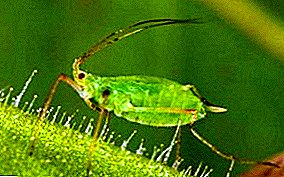 Aphid. A parasite that spoils life to many garden plants. Aphids feed on plant sap and wear it out. If a large aphid colony settles on the shrub, the plant may even die. You can fight with aphids as a national methods, and with the help of chemistry.
Aphid. A parasite that spoils life to many garden plants. Aphids feed on plant sap and wear it out. If a large aphid colony settles on the shrub, the plant may even die. You can fight with aphids as a national methods, and with the help of chemistry.- Folk: infusions on onions, garlic, chamomile (up to 200 g of the selected plant is infused into 1 liter of warm water for about 5 hours; the infusion is diluted in 10 l of water).
- Pesticides and insecticides: Doff All in One Bug Spray, Bayer Organic Pest Control, Vitax Organic 2 in 1 Pest & Disease Control (the dosage and method of use are described in the instructions).
- Thrips. Insects that suck the sap from the plant, damaging the tissue and causing it to dry. Thrips are also dangerous because they are vectors of plant diseases. To get rid of (and more often - to contain the population) from pests, one can also use both special means and folk methods.
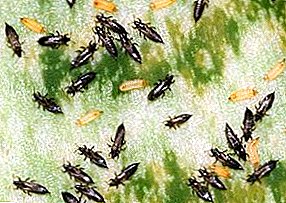 - Folk remedies: decoctions of tobacco, chilli pepper, celandine and yarrow (the aboveground body of the plant is processed).
- Folk remedies: decoctions of tobacco, chilli pepper, celandine and yarrow (the aboveground body of the plant is processed).- Insecticides: fitoverm, atelic, karbofos and konfidor. If the plant is severely affected by thrips, it is better to use insecticides, otherwise there is a risk of losing weigela.
- Spider mite Unobtrusive parasite, which, like the previous ones, feeds on plant sap. The specificity of the parasite is that it cannot be destroyed immediately: it is necessary to carry out several treatments in order to permanently expel it from the plant. Go to the means of treatment:
 - Folk remedies: tincture of garlic, onion peel; processing soap and alcohol.
- Folk remedies: tincture of garlic, onion peel; processing soap and alcohol.- Chemicals: Actellic, Fitoverm and Neoron.
Diseases that can affect weigela:
- Gray rot. The known disease of many fruit plants is subject to weigela. This is a fungus that infects the flowers and leaves of the plant. The danger of it is that with a strong defeat, it leads to the complete destruction of the shrub. To combat the disease, use the fungicide "Teldor", which is well tolerated by plants and does not cause leaf burns. Gray decay appears in heavily thickened weigel bushes and in overmoistened soil. Therefore, do not allow waterlogging of the soil, carry out loosening and cut sick and old shoots in time.
- Fusarium This infectious disease is caused by a fungus that penetrates the plant through sores and soil. Leads to decay of the root system. For the treatment using the drug "Fundazol". However, it is worth remembering that if the roots of the plant are completely affected by the disease, then the bush must be disposed of. If the damage is partial, the rotten part of the root is cut off, and the healthy part is treated with the preparation.

- Mealy dew. Microscopic ectoparasitic fungi cause the disease. First of all, leaves that are closest to the ground are affected. Strongly damaged shoots turn black and die off, the plant loses its decorative appearance, frost resistance decreases and flowering stops. To combat the powdery mildew, the following fungicides are used: Fundazole, Bayleton and Topsin. You can also use biofungicides, such as Fitosporin-M and Planriz.
Knowing the main pests and weigela diseases, you can conclude that most diseases afflict her due to improper care. As a rule, in addition to timely watering and feeding, you need to properly prune weigela in the spring so that your plants are updated and do not know the disease. These instructions will help you keep the shrub healthy and flowering.


 Aphid. A parasite that spoils life to many garden plants. Aphids feed on plant sap and wear it out. If a large aphid colony settles on the shrub, the plant may even die. You can fight with aphids as a national methods, and with the help of chemistry.
Aphid. A parasite that spoils life to many garden plants. Aphids feed on plant sap and wear it out. If a large aphid colony settles on the shrub, the plant may even die. You can fight with aphids as a national methods, and with the help of chemistry. - Folk remedies: decoctions of tobacco, chilli pepper, celandine and yarrow (the aboveground body of the plant is processed).
- Folk remedies: decoctions of tobacco, chilli pepper, celandine and yarrow (the aboveground body of the plant is processed). - Folk remedies: tincture of garlic, onion peel; processing soap and alcohol.
- Folk remedies: tincture of garlic, onion peel; processing soap and alcohol.
